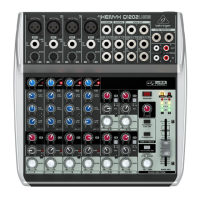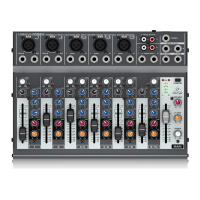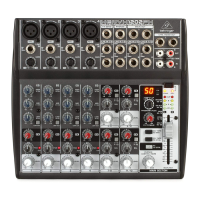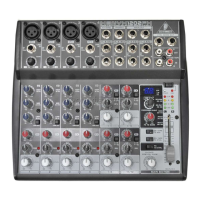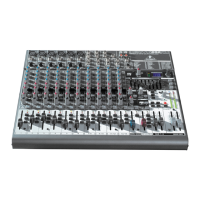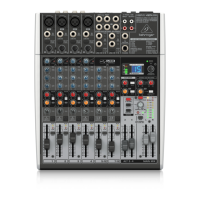1. MIC – Each mono input channel offers a balanced microphone input via the XLR connector and also features a
switchable +48 V phantom power supply for condenser microphones. The XENYX preamps provide undistorted and
noise-free gain as is typically known only from costly outboard preamps.
2. LINE IN – Each mono input also features a balanced line input on a ¼” connector. Unbalanced devices (mono jacks) can
also be connected to these inputs. Please remember that you can only use either the microphone or the line input of a
channel at any one time. You can never use both simultaneously!
3. GAIN – Use the GAIN control to adjust the input gain. This control should always be turned fully counterclockwise
whenever you connect or disconnect a signal source to one of the inputs.
4. EQ – All mono input channels include a 3-band equalizer. All bands provide a boost or cut of up to 15 dB. In the central
position, the equalizer is inactive.
5. LOW CUT – In addition, the mono channels are equipped with a steep LOW CUT filter designed to eliminate unwanted
low-frequency signal components.
6. FX – FX sends enable you to feed signals via a variable control from one or more channels and sum these signals to a
bus. The bus appears at the console’s FX send the output and can be fed from there to an external effects device. The
return from the effects unit is then brought back into the console on the stereo channels. Each FX send is mono and
features up to +15 dB gain. In the QX1002USBQX1202USB, the FX send is routed directly to the built-in effects
processor. To make sure that the effects processor receives an input signal, you shouldn’t turn this control all the way to
the left (-∞).
7. PAN – The PAN control determines the position of the channel signal within the stereo image. This control features a
constant-power characteristic, which means the signal is always maintained at a constant level, irrespective of position in
the stereo panorama.
8. LEVEL – The LEVEL control determines the level of the channel signal in the main mix.
9. CLIP – The CLIP LEDs of the mono channels illuminate when the input signal is driven too high, which could cause
distortion. If this happens, use the GAIN control to reduce the preamp level until the LED does not light anymore.
10. LINE IN – Each stereo channel has two balanced line-level inputs on ¼” jacks for left and right channels. If only the jack
marked “L” (left) is used, the channel operates in mono. The stereo channels are designed to handle typical line-level
signals. Both inputs will also accept unbalanced jacks.
11. FX – The FX sends of the stereo channels function similar to those of the mono channels. However, since the FX send
buses are both mono, a mono sum is first taken from the stereo input before it is sent to the FX bus. The Q502USB is not
equipped with FXsends.
12. BAL – The BAL(ANCE) control determines the levels of the left and right input signals relative to each other before both
signals are then routed to the main stereo mix bus. If a channel is operated in mono via the left line input,
this control has the same function as the PAN control used in the mono channels.
13. +4/-10 – The stereo inputs of the XENYX Q1002USB and Q1202USB have an input sensitivity switch that selects
between +4 dBu and -10 dBV. At -10 dBV (home-recording level), the input is more sensitive (requires less level to drive
it) than at +4 dBu (studio level).
14. STEREO AUX RETURN – Q802USB only: the STEREO AUX RETURN connectors are used to bring the output of the
external effects device (whose input is derived from the aux sends) back into the console. You can instead use these
connectors as additional inputs, but any effects device will then have to be brought back into the console via a normal
stereo channel. This does, however, give you the ability to use the channel EQ on the effects return signal if you wish. If
only the left connector is used, the AUX RETURN automatically operates in mono. Use the AUX RETURN control to
determine how much of the effects signal is sent to the main mix.
15. FX SEND – The FX SEND output (does not apply for Q502USB) should be connected to the input of an external effects
unit. The post-fader FX signal you created using the input channel FX controls is sent to the effects unit via the FX SEND
output. Use the FX SEND control of the main section to adjust the overall send level (Q1002USB and Q1202USB only).
16. PHONES/CTRL ROOM – The stereo PHONES jack (at the top of the connector panel) is where you connect
headphones. The unbalanced CTRL ROOM OUT jacks carries the summed effects and main mix signals, as well as
soloed channel signals. The PHONES/CTRL ROOM control adjusts the level of both headphones and main monitor
outputs. The Q502USB is not equipped with control room outputs.
17. MAIN MIX – The MAIN OUT connectors are unbalanced mono jacks. The main mix signal appears here at a level of 0
dBu. The MAIN MIX fader adjusts the volume of these outputs. The XENYX Q802USB and Q502USB mixing consoles
feature a rotary control for this purpose.
18. 2-TRACK INPUT – The 2-TRACK INPUTs are used to bring an external signal source (e.g. CD player, tape deck, etc.)
into the console. They can also be used as a standard stereo line input, so the output of a second XENYX or
BEHRINGER ULTRALINK PRO MX882 can be connected.
19. 2-TRACK OUTPUT – These connectors are wired in parallel with the MAIN OUT and carry the main mix signal
(unbalanced). Connect the 2-TRACK OUTPUT to the inputs of your recording device. The output level is adjusted via the
high-precision MAIN MIX fader or rotary control (Q802USB/Q502USB).
20. USB/2-TR to MAIN – When pressed, this button sends the audio from the USB and 2-TRACK inputs to the main mix
(Q502USB only).
21. USB/2-TR to PHONES – When pressed, this button sends the audio from the USB and 2-TRACK inputs to the PHONES
jack (Q502USB only).
22. FX TO CTRL ROOM – If you want to monitor only the FX send a signal in your headphones or monitor speaker(s), press
the FX TO CTRL switch. This mutes the main mix signal while routing the FX SEND output to the monitor(s). The XENYX

